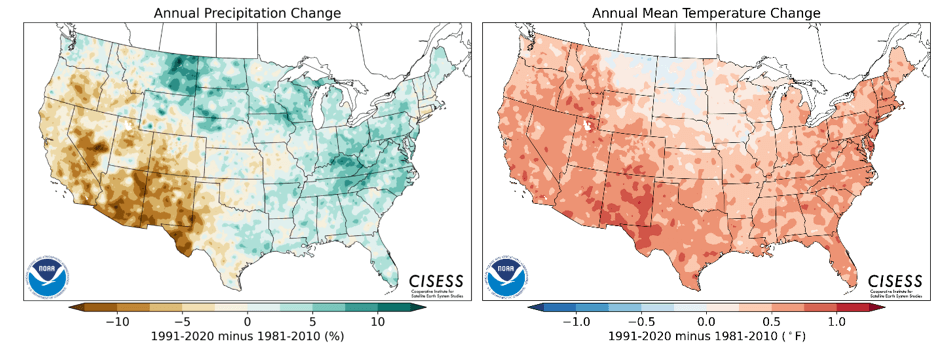US Cities and Climate Change: Status and Roadmap for the Future
Written by Elli Ntakou, F. Selin Yanikara, Jeff Schlegelmilch
Climate change has been acknowledged as an area of crisis worldwide, with record-breaking temperatures and severe storms, among many other current and looming impacts. In response, countries have created or adopted plans and formed agreements and coalitions to mitigate and adapt to climate change with tiered goals [1], [2], [6]-[8]. Central to these goals are decarbonization of our energy sector and electrification of transportation sector in addition to broader infrastructure improvements to mitigate the pace of climate change, and adaptation to the consequences that cannot be avoided, by improving resilience. In the chain of mitigation and adaptation actions needed, the participation of cities is at the forefront. On one hand, city infrastructure and services are affected by mitigation and adaptation strategies for climate change, while, on the other hand, these measures need to take into account the cities’ social environment to be effective. This article explores the current city climate plans across the US and suggests guidelines for strengthening these plans through a granular, quantitative case-specific evaluation of progress and solution ranking/prioritization based on the regulatory environment, local priorities, as well as funding and other monetary opportunities for cities. Acknowledging that the electric grid is a key enabler to climate change adaptation and mitigation measures’ application and, concurrently, a lifeline to communities, this article explores ways of effective collaboration between the city and the corresponding electric power utilities so that both parties progress against their climate and other related goals.
Impact of Climate Change to City Infrastructure
In just the first seven months of the year (2021) multiple manifestations of climate change broke international news; the recent deadly floods in China in July, the cold front in Texas in February as well as the heat wave in the Pacific Northwest in June [3] are just a few examples. Across the globe, climate experts and other expert engineering organizations, such as IEEE Power and Energy Society (PES), are also attributing the intensity of such events to climate change [3], [4]. City infrastructure can be damaged or destroyed by such phenomena and a domino effect between the assets and services directly compromised and the city’s social environment is kicked off. Often, rate payers and taxpayers are the ones bearing the burden of the financial responsibility to fix or replace assets. The costs could be in the million-dollar range or more, and more adversely impact low-income groups and communities with higher social vulnerability. Further, during the time where the assets are unavailable, residents may have less access to essential services, and may exacerbate health conditions, among other impacts. The spectrum of the knock-on effects of this depends on the asset lost, but generally impacting the most vulnerable disproportionately.

Figure 1- Change in annual precipitation and mean temperature in US between 1991-2020 period and 1981-2010 period [5]
Regulatory Scene, Mandates & Opportunities
In the United States, federal-level climate-change related policy frameworks currently include the Paris Agreement and the Build Back Better agenda [1], [6]- [8].
The regulatory environment is further shaped by targets set forth by the state governments through greenhouse gas reduction targets, usage targets [9], [10] and penalty mechanisms [11].
Cities are expected to fall in line with the federal and corresponding state goals, but also can push the envelope further and go above and beyond these targets. A wide spectrum of major and smaller cities across the country have focused on climate change, primarily targeting mitigation through the transportation sector and with monetary incentives to citizens for programs ranging from tax incentives for electric vehicle purchases, renewable energy installations, and other household improvements in support of energy efficiency.
Many cities in the state of California have had climate action plans for a while, as shown in Figure 2. The cities of Boston and San Francisco strike out as cities in the US with more comprehensive, forward-thinking climate plans at the city level [12]-[17]. Interestingly, the city of Boston is ensuring and documenting preparedness for heat events, as well as cold fronts, showcasing that the direction of climate change impacts is not a simple unidirectional temperature curve.

Figure 2 - County and city level climate action plans in the State of California [17]
Funding opportunities are currently growing, with funding for hazard mitigation from the Federal Emergency Management Agency’s (FEMA), Building Resilience Infrastructure and Communities (BRIC) and Hazard Mitigation Grant Program (HMGP) among some of the most recent infusions of resources. These programs are also an important recognition that climate disruptions are increasingly being experienced through major disasters. Examples of private funding include Amazon’s climate pledge [18], joined by more than 100 private corporations and Shell’s 2050 net zero emissions [19], among others.
But while the regulatory and priority setting moves forward, regulatory processes themselves can be myopic if they do not take into full account the cascading impacts across the social environment. And too often, those who are the most vulnerable do not have ready access to executive decision-making or complex regulatory proceedings. Exploring better policies should also include developing better policy processes, that invest in new forms of engagement, and more comprehensive metrics for success. To complicate things further, a universal approach is elusive beyond broad values expressions, and granular case-specific solutions are needed to facilitate advancement across communities.
Suggestions for Future Climate Change Plans
To this effect, this article proposes a three-fold approach for climate change mitigation and adaptation measures at the city level. The pillars of the approach are: (i) the relationship between the built environment and the city’s social environment needs to be embedded into the metrics schema, (ii) new metrics are needed to move past generic, cookie-cutter measures of performance to more effective holistic measures to inform targeted solutions and (iii) prioritization of the city investments that are informed by a cost-benefit-based optimization that properly values the cascading benefits of resilience investments.
The major components comprising a city-level climate plan that aligns with principles above include:
- Localization of forecasting of climate change impacts. Commonly used and accepted metrics for climate change and its manifestations exist (min/max temperatures, sea level rise etc).
- Comparison of the aforementioned metrics against set thresholds/targets to narrow down the areas that need improvement.
- Pairing of metrics exceeding target values with mitigation and adaptation measures. These will be rooted in either the built environment (electric grid, city infrastructure) or the health and social environment.
- Establishing strong linkages between measures and metrics of interest through sensitivity-based metrics and formally quantified relationship functions. This is a gap in current literature and industry practices.
- Formalization of investment prioritization in order to inform the optimal portfolio of measures based on net metric improvement, constrained by metrics’ desired targets, utility budgetary constraints etc.
In short, a portfolio of metrics is needed to decide which solution is the most cost effective, as well as to inform the optimal application of each solution in terms of when and where across the city. In this sense, solutions that embrace all aforementioned pillars are most effective. For example, a city should prioritize investments by weighting the benefits and costs of upgrading the city public transportation versus using monetary incentives for building energy efficiency. In order to apply said public transportation upgrades, metrics related to the city’s social environment, like demographics and income levels, will be needed to drive granular decisions of public transportation routes and schedules. Similar metrics can direct where and when incentives are more effective. Non-monetary factors that affect the prioritization of investments is, amongst others, the criticality of the infrastructure and the flexibility of the solution to solve more than one climate change concerns.
Last but not least, coordinated planning between the local utility and the city is a critical two-way street: Utilities can act as important collaborator to cities’ decarbonization efforts and vice versa, the city can help promote local utility decarbonization efforts. A good example is that of community engagement for renewable and sustainable resource adoption. Wind turbines and energy storage facilities commonly face local opposition due to sound and visual disturbances. Cities can educate residents on the benefits of cleaner energy generation and allow the utility’s clean energy and non-wires alternatives goals to be met. There is some traction on the city-utility collaboration, but currently there are only limited examples of such partnerships: A Hoboken’s substation and microgrid project were planned and operated with city-utility partnerships [20] and the city of San Diego climate plan was funded by SDG&E.
Look Ahead
Continuing our business-as-usual practices is unsustainable and needs fundamental changes imminently. The weight falls on climate change experts, local and overarching government bodies, as well as expert professional organizations (like IEEE PES) to pave the way ahead by evaluating lessons learnt, consolidating effective and ineffective solutions, and enabling collaborations between all involved parties in a structured and equitable environment.
References:
- United Nations, "The Paris Agreement," [Online]. Available: https://unfccc.int/process-and-meetings/the-paris-agreement/the-paris-agreement.
- European Union, 2030 Climate Target Plan, https://ec.europa.eu/clima/policies/eu-climate-action/2030_ctp_en
- World Weather Attribution, "Western North American extreme heat virtually impossible without human-caused climate change," 7 July 2021. [Online]. Available: https://www.worldweatherattribution.org/western-north-american-extreme-heat-virtually-impossible-without-human-caused-climate-change/.
- Y. Qian, H. Murakami, P. Hsu, S. Kapnick, “Effects of Anthropogenic Forcing and Natural Variability on the 2018 Heatwave in Northeast Asia,” in Explaining Extremes of 2018 from a Climate Perspective, Bulletin of the American Meteorological Society, 101(1), S77-S82, 2020.
- National Centers for Environmental Information, “US Climate Normals,” [Online]. Available: https://www.ncei.noaa.gov/products/land-based-station/us-climate-normals
- "Infrastructure Investment and Jobs Act," 2021.
- The White House, "UPDATED FACT SHEET: Bipartisan Infrastructure and Investment Jobs Act," 2 August 2021. [Online]. Available: https://www.whitehouse.gov/briefing-room/statements-releases/2021/08/02/updated-fact-sheet-bipartisan-infrastructure-and-investment-jobs-act/.
- C. Morehouse, "Bipartisan $1 trillion Senate infrastructure bill focuses on nuclear, carbon capture, transmission," 3 August 2021. [Online]. Available: https://www.utilitydive.com/news/bipartisan-1t-senate-proposal-focused-on-nuclear-carbon-capture-transmis/604348/.
- Center for Climate and Energy Solutions, "U.S. State Greenhouse Gas Emissions Targets," March 2021. [Online]. Available: https://www.c2es.org/document/greenhouse-gas-emissions-targets/.
- "Act 17-2019, Puerto Rico Energy Public Policy Act," 2019.
- Center for Climate and Energy Solutions, "Regional Greenhouse Gas Initiative (RGGI)," [Online]. Available: https://www.c2es.org/content/regional-greenhouse-gas-initiative-rggi/.
- "City of Boston Climate Action Plan," 2019.
- San Francisco Department of the Environment, "Climate Action Strategy," 2013.
- SF Environment, "Focus 2030: A Pathway to Net Zero Emissions," July 2019.
- City of Boston, "Preparing for Heat," July 2021. [Online]. Available: https://www.boston.gov/departments/environment/preparing-heat.
- Mayor of Boston, Barr Foundation, "Coastal Resilience Solutions for Downtown Boston and North End," 2020.
- California Air Resources Board, “California Climate Action Portal,” [Online]. Available: https://coolcalifornia.arb.ca.gov/capmap2
- https://www.theclimatepledge.com/
- Our climate target. (Shell, February 2021)
- https://nj.gov/bpu/pdf/energy/Hoboken%20Feasibility%20Study%20+%20Attachments.pdf
This article was edited by Aris Gkoulalas-Divanis
For a downloadable copy of the September 2021 eNewsletter which includes this article, please visit the IEEE Smart Cities Resource Center.



To have the eNewsletter delivered monthly to your inbox, join the IEEE Smart Cities Community.
Past Issues
To view archived articles, and issues, which deliver rich insight into the forces shaping the future of the smart cities. Older eNewsletter can be found here. To download full issues, visit the publications section of the IEEE Smart Cities Resource Center.



